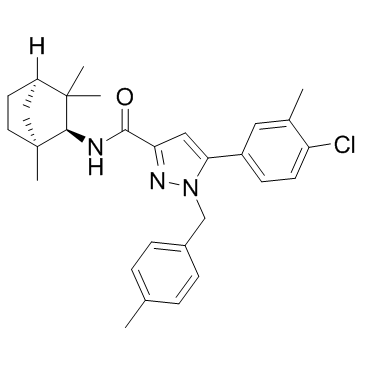| Description |
SR144528 is a potent and selective CB2 receptor antagonist with a Ki of 0.6 nM.
|
| Related Catalog |
|
| Target |
Ki: 0.6 nM (CB2 receptor)[1]
|
| In Vitro |
SR144528 is a potent and selective CB2 receptor antagonist with a Ki of 0.6 nM. SR144528 alone is able to stimulate in a concentration-dependent manner (EC50=26±6 nM, two experiments) the forskolin-sensitive adenylyl cyclase activity in CHO-CB2 cells with a maximum effect at 1 μM (4-fold stimulation) whereas at this concentration it has no significant effect on CHO-CB1 cells (15% inhibition)[1]. Raw 264.7 macrophages supplemented with SR144528 display reduced caspase-3 activity. SR144528 inhibits microsomal acyl-coenzymeA:cholesterol acyltransferase (ACAT) activity in a concentration-dependent manner with an IC50 value of 3.6±1.1 μM. At 10 μM, SR144528 inhibits ACAT activities ~68%[2].
|
| In Vivo |
No effect on the binding of [3H]-CP 55,940 to its specific sites in the brain is observed after either oral (up to 10 mg/kg) or i.c.v. (10 μg/animal) administration of SR144528 in mice. The occupancy by SR144528 of the spleen cannabinoid receptor is time-dependent and significant for at least 18 hours after oral administration at 3 mg/kg[1]. SR144528 does not induce any significant effect on gastrointestinal (GI) motility when given alone. SR144528 does not block but enhances delayedgastric emptying[3].
|
| Kinase Assay |
MAP kinase activity is measured. Briefly, cells grown to 80% confluence are maintained in culture medium containing 0.5% foetal calf serum for 24 hour prior to the application of ligands. CHO-CB1 or -CB2 cells previously washed with PBS are incubated at 37°C in the absence (basal activity) or in the presence of SR144528 (10-9 to 3×10-6 M) for 20 min. Cells are then washed at 4°C with 0.5 mL of buffer A [50 mM Tris-HCl, pH 7.5, 150 mM NaCl, 1 mM ethyleneglycol-bis-(β-aminoethyl ether) N,N,N′,N-tetraacetic acid, 1 mM Na3PO4] and lysed for 15 min in buffer A supplemented with 1% triton X-100, 10 μg/mL aprotinin, 10 μg/mL, leupeptin, 1 mM dithiothreitol and 1 mM phenylmethylsulfonyl fluoride. The solubilized cell extracts are then clarified by centrifugation at 14,000× g for 15 min at 4°C. Aliquots (15 μL) are removed and stored at -80°C until use. Phosphorylation assays are carried out at 30°C for 30 min (linear assay conditions) with γ-[33P]ATP by using the p42/p44 MAP kinase enzyme system. The radioactivity incorporated is determined by liquid scintillation counting[1].
|
| Cell Assay |
cAMP accumulations are carried out in CHO-CB1 or -CB2 cells. Cells are washed with phosphate-buffered saline (PBS) and incubated for 15 min at 37°C in 1 mL of PBS in the absence or in the presence of SR144528 (3×10-9 to 10-5M). Forskolin (3 μM final concentration) is added and cells are incubated for another 20 min at 37°C. The reaction is terminated by rapid aspiration of the assay medium and addition of 1.5 mL of ice-cold 50 mM Tris-HCl, pH 8, 4 mM ethylenediaminetetraacetic acid. Dishes are placed on ice for 5 min and then the extracts are transferred to a glass tube. Extracts are boiled and centrifuged for 10 min at 3500 g to eliminate cell debris. Aliquots from supernatant are dried and the cAMP concentration is determined by radioimmunoassay by using the scintillant proximity assay system. The basal activity is determined in the absence of forskolin[1].
|
| Animal Admin |
Male Wistar rats (240 to 300 g) are used in this study. One week after the animals arrived at the laboratory, three different sets of experiments are carried out. In the third set of experiments, SR144528 (1 mg/kg i.p.) is administered in rats. The effect of SR144528 is also analyzed in vehicle-treated rats. SR144528 volume is adjusted to a maximum of 4 to 5 mL/kg[3].
|
| References |
[1]. Rinaldi-Carmona M, et al. SR 144528, the first potent and selective antagonist of the CB2 cannabinoid receptor. J Pharmacol Exp Ther. 1998 Feb;284(2):644-50. [2]. Thewke D, et al. AM-251 and SR144528 are acyl CoA:cholesterol acyltransferase inhibitors. Biochem Biophys Res Commun. 2009 Apr 3;381(2):181-6. [3]. Abalo R, et al. The cannabinoid antagonist SR144528 enhances the acute effect of WIN 55,212-2 on gastrointestinal motility in the rat. Neurogastroenterol Motil. 2010 Jun;22(6):694-e206.
|
